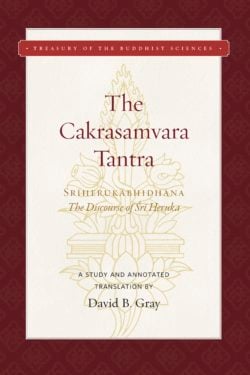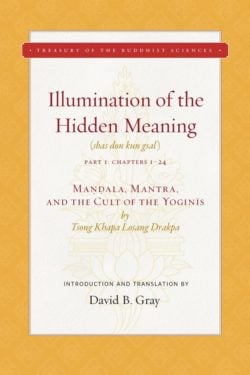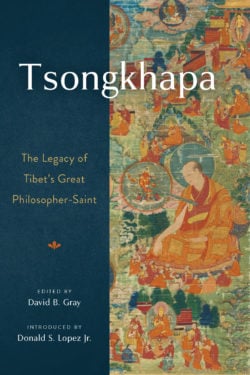David B. Gray

David B. Gray is Bernard J. Hanley Professor of Religious Studies at Santa Clara University. He is the author of The Cakrasamvara Tantra (The Discourse of Sri Heruka): A Study and Annotated Translation (AIBS 2007); The Cakrasamvara Tantra (The Discourse of Sri Heruka): Editions of the Sanskrit and Tibetan Texts (AIBS 2009); Tsong Khapa’s Illumination of the Hidden Meaning: Mandala, Mantra, and the Cult of the Yoginis (Chapters 1–24) (AIBS 2015); Tsong Khapa’s Illumination of the Hidden Meaning: Yogic Vows, Conduct, and Ritual Praxis (Chapters 25–51) (AIBS/WP 2019).
Books, Courses & Podcasts
The Cakrasamvara Tantra (The Discourse of Sri Heruka)
Composed in India during the late eighth or early ninth century, this text is a foundational scripture of one of the most important Indian Buddhist tantric traditions, as evidenced by the vast number of commentaries and ritual literature associated with it. Along with the Hevajra Tantra, it is one of the earliest and most influential of the Yogini Tantras, a genre of tantric Buddhist scripture that emphasizes female deities, particularly the often fiercely depicted yoginis and dakinis.
The author’s introductory essay provides an analysis of the historical and intellectual contexts in which the tantra was composed, including its complex interrelationship with Hindu Saiva traditions, and investigates the history of its adaptation by Buddhists. The translation was made on the basis of the surviving Sanskrit manuscripts of the tantra and its commentaries, as well as parallel passages in related explanatory tantras (vyakhyatantra). It is also takes into consideration two different Tibetan translations of the root text, and several Tibetan commentaries. The translation itself is heavily annotated, with extensive translations from the Indian and Tibetan commentaries on the text. Includes a trilingual glossary and index.
The author has now also translated the commentary on this tantra by the great Tibetan scholar Tsong Khapa (1357–1419), which appears in two volumes as Illumination of the Hidden Meaning. Taken together, these three volumes provide the reader with the first full study in English of this pivotal tantra.
Illumination of the Hidden Meaning, Vol. 1
This is the first volume of the annotated translation of Tsong Khapa’s Illumination of the Hidden Meaning (sbas don kun gsal), a magnificent commentary on the Cakrasamvara Tantra. This is the first English translation of this important work, which marked a milestone in the history of the Tibetan understanding and practice of the Indian Buddhist tantras.
This first volume, which includes Tsong Khapa’s detailed introduction to chapters 1–24 of the 51-chapter Cakrasamvara root tantra, covers the history of the tradition, its interpretation, and a wide range of topics including the construction of the maṇḍala, the consecration therein, the decoding of mantras and their ritual applications, and details concerning the clans of the yoginīs.
The author situates the work in context, and explores in depth the sources used by Tsong Khapa in composing this commentary. He also provides detailed notes, a trilingual English–Tibetan–Sanskrit glossary, and an appendix that includes a translation of Sumatikīrti’s synopsis of the Cakrasamvara Tantra entitled the Laghusaṃvaratantrapaṭalābhisandhi, which is quoted by Tsong Khapa in its entirety in his commentary.
Together with the author’s related publications in this series—including translations of the root Cakrasamvara Tantra (2007, 2010, 2019); the critically edited Sanskrit and Tibetan texts of the root tantra (2012); and the second volume of this master Tibetan commentary (chapters 25–51), subtitled Yogic Vows, Conduct, and Ritual Praxis (2019)—the reader will have the first full study of this important tantra available in English.
Illumination of the Hidden Meaning, Vol. 2
This is the second of two volumes presenting Dr. David Gray’s study and translation of the Illumination of the Hidden Meaning (sbas don kun gsal) by the Tibetan Buddhist scholar-yogi Tsong Khapa Losang Drakpa (1357–1419). The Illumination contains Tsong Khapa’s magnificent commentary on the Indian Buddhist Cakrasamvara Tantra, one of the earliest and most influential of the yoginī tantras, a genre of tantric Buddhist scripture that emphasizes female deities, particularly the often fiercely depicted yoginīs and ḍākinīs. Together with the first volume, this contains the first English translation of this important work that marks a milestone in the history of the Tibetan assimilation of the Indian Buddhist tantras.
This second volume, which includes Tsong Khapa’s detailed introduction to chapters 25–51 of the 51-chapter Cakrasamvara root tantra, covers the vows, observances, and conduct of the initiated yogī, particularly in relation to the yoginīs, whose favor he must cultivate. It describes in great detail the rites of the tradition, including homa fire sacrifice and the uses of the mantras of the maṇḍala’s main deities. The author provides a trilingual English–Tibetan–Sanskrit glossary.
Together with the author’s related publications in this series—including translations of the root Cakrasamvara Tantra (2007, 2010, 2019); the critically edited Sanskrit and Tibetan texts of the root tantra (2012); and the first volume of this master Tibetan commentary (chapters 1–24), subtitled Maṇḍala, Mantra, and the Cult of the Yoginīs (2017)—the reader will have the first full study of this important tantra available in English.
Tsongkhapa
Tsongkhapa’s seminal contributions to Buddhist thought and practice, and to the course of history, are illuminated and celebrated by some of his foremost modern interpreters.
Few figures have impacted the trajectory of Buddhism as much as the great philosopher and meditator, scholar and reformer, Tsongkhapa Losang Drakpa (1357–1419), the founder of the Geluk school of Tibetan Buddhism and teacher of the First Dalai Lama. His Ganden tradition spread throughout Central Asia and Mongolia, and today, through figures such as the Dalai Lama, who calls Tsongkhapa a second Nagarjuna, his teachings are shaping intellectual conversations and ethical practice globally. To commemorate the 600th anniversary of Tsongkhapa’s passing, a special conference was held at Ganden Monastery in India in 2019, featuring some of the best translators and interpreters of his teachings today. Highlights of those incisive summations of Tsongkhapa’s special contributions are gathered in this volume. Here we discover Tsongkhapa the philosopher, Tsongkhapa the master of the Buddhist canon, Tsongkhapa the tantric adept, and Tsongkhapa as the visionary who united wisdom to compassion.
Each of the authors featured looks at a distinct facet of Tsongkhapa’s legacy. Donald Lopez provides a global context, Guy Newland distills Tsongkhapa’s Middle Way, Dechen Rochard uncovers the identity view, Jay Garfield examines the conceptualized ultimate, Thupten Jinpa highlights the seminal importance Tsongkhapa placed on ascertainment, David Gray looks at his approach to Cakrasamvara tantra, Gavin Kilty surveys his Guhyasamaja tantra commentary, Roger Jackson surmises his views on Zen and mahamudra, Geshé Ngawang Samten examines his provisional-definitive distinction, Gareth Sparham highlights his scholastic prowess, Mishig-Ish Bataa illuminates his impact in Mongolia, and Bhiksuni Thubten Chodron presents his instructions on how to cultivate compassion.
Whether you are well acquainted with Tsongkhapa’s life and thought or you are encountering him here for the first time, you will find The Legacy of Tsongkhapa an illuminating survey of his unique explorations of the highest aspirations of humanity.




